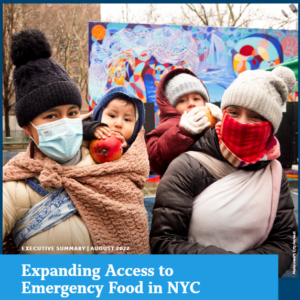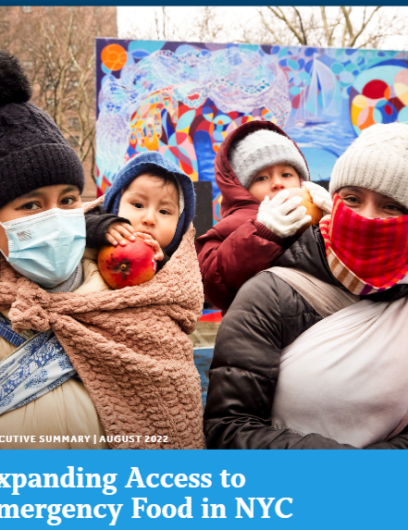 Prior to COVID-19, three-quarters of New Yorkers facing persistent food hardship did not access free emergency food. In early 2021, the New York City Mayor’s Office of Food Policy raised money from local philanthropy to convene a group of leading emergency food stakeholders to develop and pilot a plan to close the access gap.
Prior to COVID-19, three-quarters of New Yorkers facing persistent food hardship did not access free emergency food. In early 2021, the New York City Mayor’s Office of Food Policy raised money from local philanthropy to convene a group of leading emergency food stakeholders to develop and pilot a plan to close the access gap.
The group designed an innovative distribution model targeting three types of access barriers:
- Limited intent to engage related to stigma, misperceptions of eligibility, and lack of awareness
- Lack of physical access due to distant pantries, inconvenient hours, and long wait times
- Negative pantry experiences including low-quality food, limited choice, and difficult interactions
Partnering with Community-Based Organizations (CBOs)
The model uses trusted community-based organizations (CBOs) such as churches, day-cares, and shelters to reach food insecure families and provide a convenient pickup spot for food. CBOs leverage existing technology tools to allow clients to share input and select food items. Sophisticated food providers (Fulfillment Partners) receive client’s orders and distribute food to CBOs.
The group piloted the model at eight CBO sites in neighborhoods with high unmet need. Over approximately four months, the model proved a success in reaching new people. Of more than 1,400 unique households across the eight pilot sites, 57% were new to the emergency food system (i.e., did not access free food prior to the COVID-19 pandemic), far exceeding the pilot’s initial target of 20%.
An evaluation of the pilot surfaced key learnings that food providers and food funders can consider in trying to reach new people with charitable food. Click the button to the right to download the full report.
Learn more
Do you have any questions about the report’s background, content, or implications for your own work? Please reach out. We’d love to help.
